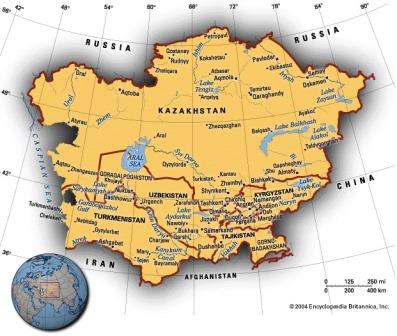Central Asia - cradle of Antique Civilization

Central Asia’s landscape can be divided into the vast grassy steppes of Kazakhstan in the north and the Aral Sea drainage basin in the south. About 60 percent of the region consists of desert land, the principal deserts being the Kara-Kum, occupying most of Turkmenistan, and the Kyzyl-Kum, covering much of western Uzbekistan. Most of the desert areas are unsuitable for agricultural use except along the margins of the Amu Darya and Sir Darya river systems, which wind their way northwestward through Kyrgyzstan, Tajikistan, and eastern Uzbekistan and Turkmenistan after rising in mountain ranges to the south and east. These two major rivers drain into the Aral Sea and provide most of the region’s water resources, though northern Kazakhstan is drained by rivers flowing north into Russia. On the east and south Central Asia is bounded by the western Altai and other high mountain ranges extending into Iran, Afghanistan, and western China.
Central Asia experiences very dry climatic conditions, and inadequate precipitation has led to heavy dependence on the Sir Darya and Amu Darya for irrigation. The region as a whole experiences hot summers and cool winters, with much sunshine and very little precipitation. The scarcity of water has led to a very uneven population distribution, with most people living along the fertile banks of the rivers or in fertile mountain foothills in the southeast; comparatively few live in the vast arid expanses of central and western Kazakhstan and western Uzbekistan and Turkmenistan.
The five largest ethnic groups in Central Asia are, in descending order of size, the Uzbek, Kazak, Tajik, Turkmen, and Kyrgyz. All these groups speak languages related to Turkish except for the Tajik, who speak a language related to Persian. Islam is the dominant religion, with most adherents belonging to the Sunnite branch. As a result of the region’s historical incorporation into Russia and then the Soviet Union, large numbers of Russians and Ukrainians give it a distinctive multiethnic character. Population growth in Central Asia has been quite rapid in the 20th century owing to high birth rates and Soviet health measures that brought down mortality rates. The region experienced environmental problems in the late 20th century owing to the effects of rapid agricultural development, overdependence on irrigation, and the effects of Soviet nuclear-weapons testing in some areas.
Central Asia’s economic activity is centered on irrigated agriculture in the south and on heavy and light industry and mining in Kazakhstan. Under Soviet rule the area supplied most of the U.S.S.R.’s cotton and was a major supplier of coal and other minerals for industrial use. Irrigated cotton-growing is dominant in the east and southeast, while there is some dry farming of wheat in the far northern provinces of Kazakhstan, where the Soviets’ Virgin and Idle Lands program of the 1950s brought much steppe under the plow for the first time.
The human occupation of Central Asia dates back to the late Pleistocene Epoch, approximately 25,000 to 35,000 years ago, but the first identifiable human groups to live there were the Cimmerians and Scythians (1st millennium bc) in the west and the Hsiung-nu people (from 200 bc) in the east. In the 6th century bc the first Turkic peoples established an empire that lasted for two centuries and greatly influenced the region’s subsequent ethnic character. Another Turkic people, the Uighurs, rose to dominance in the 8th century, and their rule in turn gave way to that of the Khitans and then to the Karakhanids, a Turkic people closely related to the Uighurs. The region was gradually Islamized beginning in the 11th–12th century, a process that was virtually complete by the 15th century. The Mongols took over almost all of Central Asia in the 13th century, and their rule in the form of various independent khanates lasted until Timur’s conquests about 1400. Following the breakup of his dynasty, southern Central Asia became divided into several rival khanates that were ruled by his descendants. By the end of the 15th century all of these Timurid possessions had fallen into the hands of the Uzbek people.
Russia’s conquest of the region began in the 17th century and continued until the last independent Uzbek khanates were annexed or made into protectorates in the 1870s. Soviet rule replaced that of the Russian tsars after the Russian Revolution of 1917, and thereafter the region was increasingly integrated into the Soviet system through a planned economy and improved communications. In the 1920s and ’30s the Soviet government created five Soviet socialist republics out of the region: the Kazakh S.S.R., the Uzbek S.S.R., the Kirgiz S.S.R., the Tajik S.S.R., and the Turkmen S.S.R. Under Soviet rule, southern Central Asia undertook the large-scale cultivation of cotton to supply the U.S.S.R.’s textile industry with raw material. When the Soviet Union collapsed, all five Central Asian Soviet socialist republics obtained their independence in 1991, becoming the sovereign and independent nations of Kazakhstan, Uzbekistan, Kyrgyzstan, Tajikistan, and Turkmenistan.








 +99890 979 38 98
+99890 979 38 98 +99871 252 52 32
+99871 252 52 32 +99871 252 61 84
+99871 252 61 84



























